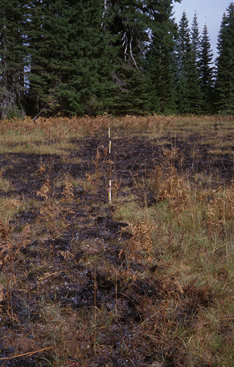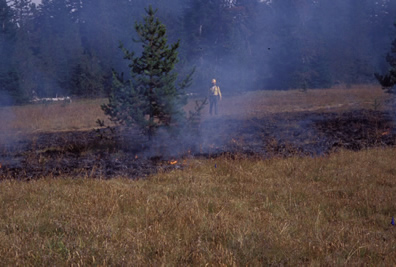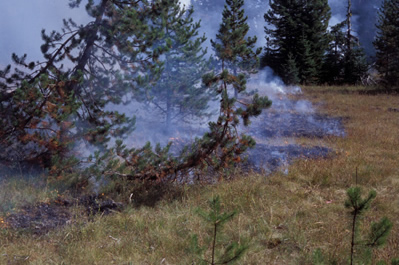|
Restoration
of Dry Montane Meadows Through Prescribed Fire, Vegetation and Fuels
Management: A Program of Research and Adaptive Management in Western Oregon |
|
Abstract of Research Plan Mountain meadows comprise a relatively small portion
of the largely forested western Cascade landscape, but serve many important
ecological and social functions. Meadows
support a distinct and diverse assemblage of plant species, including
rare and endemic taxa; provide habitat and forage for wildlife; and
offer recreational opportunities for hikers who seek colorful displays
of wildflowers and scenic vistas. Invasion
of these meadows by trees represents a fairly recent, but widespread
phenomenon. Our previous studies
in the central Cascade Range of Oregon suggest that these invasions
have been triggered by a variety of factors including changes in regional
climate and cessation of sheep grazing during middle part of the century. The role that fire has played in the maintenance
of mountain meadows is less clear, but it is likely that periodic burning
(of natural or anthropogenic origin) has been important in creating
and maintaining openings, particularly on dry, south- and west-facing
slopes and ridgetops. Although
anthropogenic ignitions are known to have been important in maintaining
open conditions in lowland valleys of western Oregon, evidence of aboriginal
burning of mountain meadows is lacking for the central Cascades. During the post-European settlement period (ca. 1850-1890), human-induced
fires are know to have occurred in association with road building, sheep
grazing, and camping. Twentieth
century fire suppression, however, may be permitting gradual succession
of meadow to forest with profound consequences for local and regional
patterns of plant diversity. As a consequence, natural resource managers in the Pacific Northwest have begun to consider prescribed fire as a tool to “restore” meadow composition and structure¾to reintroduce fire as a process that, historically, had contributed to the origin and long-term maintenance of these ecosystems. With limited knowledge of the historical role of fire in these systems, managers have little information to guide restoration efforts. We propose a program of experimental research, adaptive management, and outreach that will contribute to our understanding of the natural dynamics of these systems, to their restoration and maintenance, and to public appreciation of the roles of scientists and land managers in restoring ecosystem health. We bring together scientists and resource specialists with a long, successful history of collaboration to develop a demonstration center at Bunchgrass Meadow on the Willamette National Forest, Oregon. We propose two integrated studies at Bunchgrass. The first -- which documents the history of invasion and the current range of vegetation conditions -- provides the historical and ecological contexts for the second study, which evaluates vegetation responses to experimental restoration treatments. Thinning and prescribed burning will be implemented across replicate sites representing the full range of vegetation conditions at Bunchgrass. Permanent transects and nested plots sampled prior to treatment will be used to assess changes in species composition and diversity, mortality of residual trees, and establishment of conifer seedlings. Uni- and multivariate statistical techniques will be used to explore the nature and range of vegetation responses, and to identify the initial conditions that lead to successful outcomes. We have designed these studies to yield useful short-term products for scientists, managers, and the public, and in doing so, to provide opportunities for ongoing research, experimentation, and education. Our goal is to build a solid basis for successful restoration of meadows throughout the western Cascades, using Bunchgrass Meadow as a regional center for research, adaptive management, and outreach Full proposal can be found here (.pdf file). Poster presented at the 2005 Joint Fire Science Program Annual Workshop can be found here (.pdf file).
|
  |
  |
|
Aerial photo of
the study area with the meadow boundary outlined in yellow. In the southwest
corner are transects (see upper right photo) used in a preliminary study
of vegetation response to prescribed fire (lower two photos, 11 October
1999). See full establishment report (.pdf file). |
Related phytosociological studies of montane and subalpine meadows
Related studies of conifer invasion of meadows